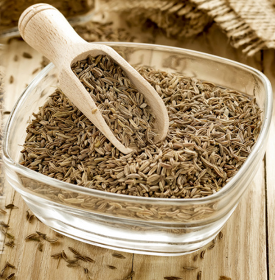





Botanical name Cuminum cyminum L.
Family Apiaceae
Source Seeds
Origin India
Processing Method Steam Distilled
Color/Consistency A thin, pale yellow-greenish to brownish liquid.
Aromatic Summary / Note / Strength of Aroma A middle note with a medium strength of aroma, it has a characteristic warm, spicy and musky scent.
Blends With Angelica Root, Caraway, Lavender, Rosemary, Chamomile, and essential oils with an oriental flavor.
Product Abstract
Cumin, scientifically known as Cuminum cyminum, belongs to the family Apiaceae. It is extensively used as a condiment or a spice in culinary practices of the Indian Subcontinent and some other Asian, African and Latin American countries. Cumin Boasts a number of important nutrients that can help keep you healthy. Because of its strong aroma, only a small amount of cumin esential oil is used in recipes to provide these with a powerful punch. Cumin essential oil is also attributed to its bactericidal, carminative, digestive, diuretic and antiseptic properties for numerous other benefits.
History
Cumin has been in use since ancient times. Seeds excavated at the Syrian site Tell ed-Der have been dated to the second millennium BC. They have also been reported from several New Kingdom levels of ancient Egyptian archaeological sites. In the ancient Egyptian civilization, cumin was used as spice and as preservative in mummification
Extraction Information
we carried out the extraction of the essential oil of cumin by the hydrodistillation 4,5 . The collected extract was analyzed by using the gas chromatography coupled with the mass spectroscopy method 6,7. The results allowed to know the chemical composition of essential oil, which compared with other works showed a great similarity.
Common Usage
Caution
This Essential Oil has phototoxic properties and exposure to the sun must be avoided after application to the skin. Due to their presence, please consult a physician prior to using this oil. Dilute well before use; for external use only. May cause skin irritation in some individuals; a skin test is recommended prior to use. Contact with eyes should be avoided.
Key constituents
Cuminaldehyde 19.8–40.0%
g-Terpinene 11.2–32.0%
b-Pinene 4.4–17.7%
p-Cymene 5.9–17.5%
p-Mentha-1,3-dien -7-al 7.2–3.2%
p-Mentha -1,4-dien-7-al 2.1–8.6%
b-Myrcene þ a-phellandrene 0.5–7.3%
p-Menth-3-en -7-al 0.5–2.5%
Cuminyl alcohol 0.2–2.2%
a-Pinene 0.2–1.2%
Isocaryophyllene 0.1–1.1%
Quality May be adulterated with additional cuminaldehyde
Safety summary
Hazards Phototoxic (moderate risk).
Contraindications (dermal) If applied to the skin at over maximum use level, skin must not be exposed to sunlight or sunbed rays for 12 hours.
Maximum dermal use level 0.4%
Regulatory guidelines
Has GRAS status. To avoid phototoxicity, applications on areas of skin exposed to sunshine, excluding bath preparations, soaps and other wash-off products, cumin oil should be limited to 0.4%
Organ-specific effects
Adverse skin reactions Undiluted cumin oil was moderately irritating to rabbits, but was not irritating to mice; tested at 4% on 25 volunteers it was neither irritating nor sensitizing. Distinct phototoxic effects were reported for cumin oil, but none for cuminaldehyde. RIFM apparently reported a 5% NOAEL for phototoxicity in human volunteers.
Systemic effects
Acute toxicity Cumin oil acute oral LD50 in rats 2.5 mL/kg; acute dermal LD50 in rabbits 3.56 mL/kg.
arcinogenic/anticarcinogenic potential Cumin oil was not mutagenic in the Ames test, and did not produce CA in Chinese hamster fibroblasts. Cumin oil dosedependently inhibited aflatoxin B1-induced adducts in calf thymus DNA, in the presence of rat liver microsomes. It increased glutathione S-transferase activity in the stomach, liver and esophagus of mice by more than 78%, and significantly inhibited B[a]P-induced squamous cell stomach carcinoma.
Comments
The restriction is poorly worded, since it does not clearly address leave-on products on areas of skin not obviously exposed to sunshine.